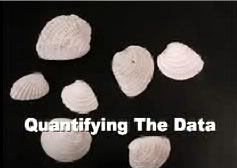How do you Quantify Change?

Do two fossils with slightly different morphology
collected from a
sequence of rocks represent evolutionary change? This section of the module
addresses this
question by engaging you in the process of quantifying and examining
data and then using that data to validate or reject an inferred
evolutionary relationship. In order to examine how morphologic
variables have changed over time we need a way to quantify
them. Paleontologists often need to measure dozens of different
parameters in a fossil before they find one that seems to change over
time. Dr. Patricia Kelley, whose data set we are using,
determined after thousands of measurements that for the bivalves Astarte and Anadara,
two variables - internal volume of the shell and shell thickness-
showed change over time. How do you measure the internal volume of a
bivalve?
How do you measure shell thickness? This part of module
will take
you inside the laboratory, where you will learn how field data is
quantified,
graphed, and examined. Critical examination is
necessary in order to determine whether the trends in the data show
evolutionary change or a reversible response to changing conditions
("morphologic plasticity").
Click on the photograph for a video
demonstrating a geologist
quantifying collected shell data!
Back
| Home | Next
